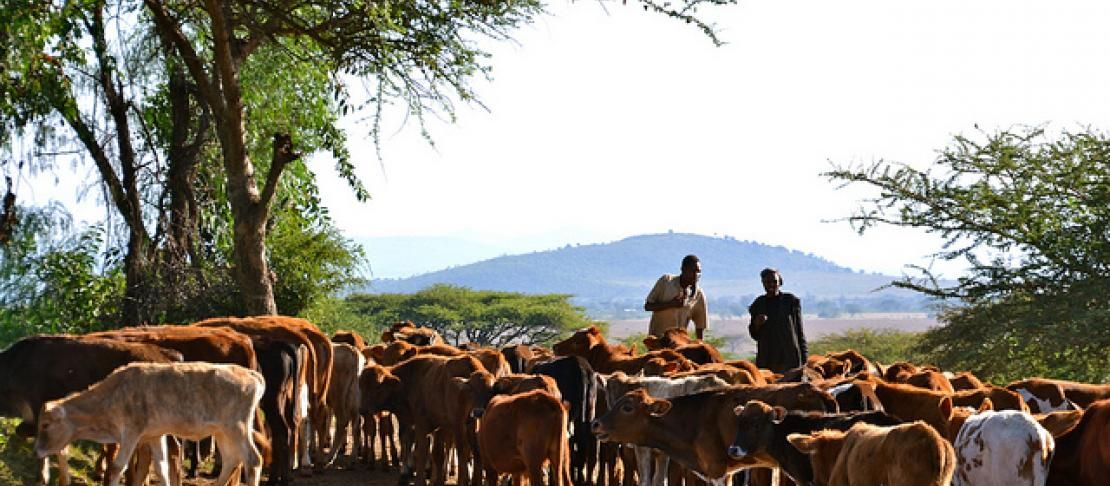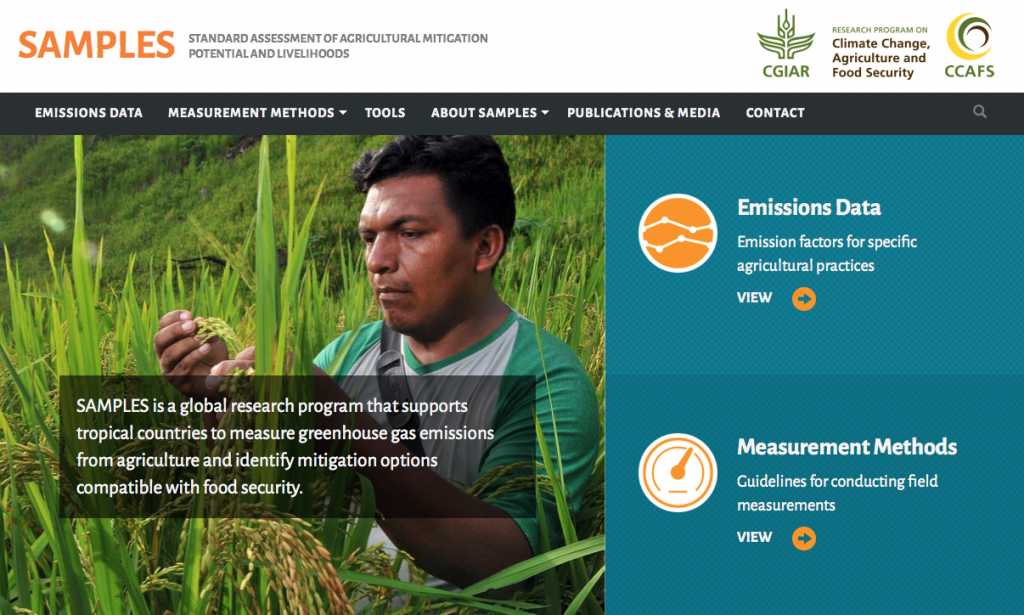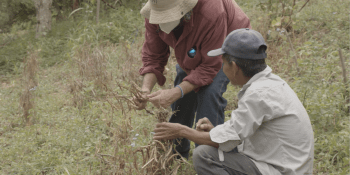Livestock mitigation: opportunities for farmers, climate agreements across the globe

At climate change talks in Bonn, leading countries, scientists and specialists show they are ready for climate finance in the livestock sector.
Global climate change agreements now support the widespread adoption of agricultural practices that improve productivity and decrease emissions, including the livestock sector, which causes 14% of all human-induced greenhouse gas emissions and has significant, achievable mitigation potential.
At climate change talks in Bonn, leading countries, scientists, and specialists show they ready for climate finance in the livestock sector. The CGIAR Research Programme on Climate Change and Food Security (CCAFS) and the World Agroforestry Centre (ICRAF) hosted a side event to showcase progress and pathways for countries interested in climate finance for agricultural mitigation through livestock. Experts, including a lead negotiator, explained three active NAMA proposals that will reduce emissions while improving livestock productivity in Costa Rica, Kenya and Mongolia, and panelists addressed monitoring, reporting and verification (MRV), public-private partnerships and financing opportunities.
As countries plan to scale up mitigation in the livestock sector through support from the NAMA Facility, CCAFS, the International Centre for Tropical Agriculture (CIAT) and ICRAF, are supporting the NAMA process and other climate financing opportunities in developing countries through research, planning and technical support, conducted in collaboration with partners governments and other CGIAR centers and programs. Existing work includes measurement of greenhouse gas emissions through the SAMPLES project, livestock NAMA support by CIAT in Costa Rica and ICRAF in Kenya and Mongolia, and technical and policy capacity building support with national country offices and development organizations.
Costa Rica on track to be carbon neutral with livestock NAMA
“23.6% of all emissions in Costa Rica come from the livestock sector," said Giovanna Valverde, lead negotiator for the government of Costa Rica. "We can mitigate emissions in livestock by choosing climate-smart practices that are informed by science and may also reduce use of labour, increase soil fertility, save water, and bring more benefits to farmers.”
With 80% of the country’s population supporting low-carbon activities, Costa Rica has ambitious targets for its livestock NAMA. Costa Rica’s 15-year greenhouse gas mitigation target will cover 70% of the country’s herd and 60% of the land area, amounting to savings of 6 million tons of carbon dioxide. The strategy involves the use of rotational grazing, pasture management, improved fertilization plans and live fencing.
Impressive potential emissions reductions, livelihood gains in Kenya and Mongolia
Timm Tennigkeit of Unique Forestry and Land Use presented findings that existing climate-smart livestock management practices can reduce livestock emissions by 18-30% without a decrease in gross production. In livestock, as in agriculture in general, mitigating emissions does not mean slowing production.
“Potential improvements to the livestock sector are wide and include increased market access, decreased fragmentation of value chains, improved private sector participation and stable milk supplies. In turn, this increases incomes and improves nutrition for rural people engaged in livestock-based livelihoods,” Timm explained.
The Government of Kenya has been working with UNIQUE, CCAFS and ICRAF to implement dairy NAMAs. They estimate that the dairy sector alone could:
- Decrease the country’s emissions by 3.3% of its 2010 emissions
- Scale up to reach 1.8 million households
- Increase smallholder farmer income by USD 1,000-2,000 per year
- Sustain the existing 180,000 jobs in the dairy value chain.
UNIQUE is also working in Mongolia, where livestock mitigation is tied to grassland restoration and is likely to inform the Central Asian region. Livestock interventions include changing herd size and structure and improved breeding. Both interventions increase herders’ climate resilience and improve livelihoods as well as generate potential reductions that equal almost one-third of Mongolia’s energy sector.
CCAFS and partners gathering data, identifying options
Science plays a critical role, providing the research and data that inform and shape low emissions programs. CCAFS, CGIAR centres such as CIAT and ICRAF, and their public and private partners, are committed to providing the science base and support that countries around the world need to develop and implement climate-smart livestock innovations. Existing data on agricultural greenhouse gas emissions in Africa and other smallholder countries is scant, but growing.
“Through the SAMPLES project, we have developed low-cost measurement methods for agricultural greenhouse gas sources and sinks, and we have established emission factors for smallholder systems that are much more accurate than rough emission factors commonly adopted because of lack of information,” said Henry Neufeldt, ICRAF’s climate change leader. “Use of aerial photography, remote sensing and crowd sourcing provides better data on greenhouse gas emissions.”

MEasurement methods and initial emission factors are available on the samples website, and more information on ongoing research is available upon request.
Farmers, private sector are key actors
Panelist Manyewu Mutabmba of the Southern African Confederation of Agricultural Unions (SACAU) noted that many crop farmers are transitioning to also have livestock or even switch to livestock to meet demand.
Along with consumer demand from the local market, farmers depend on their products’ value chains for dependable markets. In all three case studies, participation of the private sector in livestock is essential to operationalize and sustain low-emissions activities.
Private sector support is being garnered at smaller and larger scales. In Kenya for example, Livelihoods, a fund supported by the dairy giant Danone and conservation organizations, is investing in the dairy sector and is supportive of the same mitigation activities that would compose a dairy NAMA.
NAMA Facility, Green Climate Fund to expand financing
Nationally Appropriate Mitigation Actions (NAMAs) were introduced in the Bali Action Plan of 2007 as a commitment by developing countries to reduce greenhouse gas emissions. Agriculture, being the major economic activity in several countries, is the most effective strategy to achieve mitigation for many developing countries. Despite the recognition of the role of agriculture in climate change mitigation and adaptation efforts, agriculture was first addressed in official climate agreements only this year.
In tandem with this recognition, the NAMA Facility has an open call for proposals, and the Green Climate Fund is preparing to make its first awards in 2016.
Resources for mitigation in agriculture are growing
NAMAs can support the implementation of Intended Nationally Determined Contributions (INDCs). They are designed to be aligned with country and sector specific needs, and they include private and public resources. And resources for mitigation in agriculture are growing.
“The Green Climate Fund is expected to be the main financing mechanism for livestock NAMAs going forward,” Rutger de Witt Wijnen from the Green Climate Fund said. “Since the assessment criteria for the NAMA Facility and the Green Climate Fund should be similar, countries can see which climate finance mechanism best matches their trajectories.”
Support for mitigation in the agricultural sector, including NAMAs and expected funding from the Green Climate Fund, is expected to increase in the context of the SBSTA, COP and the submission of INDCs.
Participants at the side event agreed that agricultural NAMAs can finance reduced emissions while also supporting agricultural production and smallholder livelihoods.
“Livestock provides an opportunity to mitigate and help farmers,” one participant at the side event said. “Climate finance is an opportunity to scale up mitigation.”
See the program for the side event.
Learn more about other climate-smart agricultural practices:
Julianna White is program manager of low emissions agriculture research at CCAFS. Susan Onyango is the communications specialist for climate change research at ICRAF.
To follow progress on agriculture at SBSTA June 2015 please have a look at our blog series, and follow @cgiarclimate on twitter.



